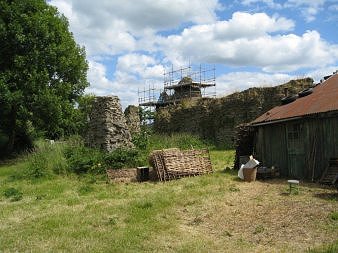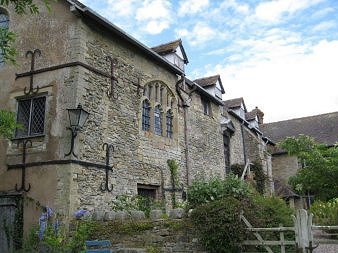Wigmore Abbey
Wigmore abbey has a long, unusual and convoluted foundation history. Ralph Mortimer, the first Mortimer of Wigmore, received a grant from King Henry I (1100-35) to found an abbey in his Herefordshire lands, but apparently did not act upon this. This was probably due to his expulsion from England due to his daughter's treason in the 1120's. It therefore fell to Oliver Merlymond to found a priory at initially Shobdon. This priory was suppressed by Hugh Mortimer who made intermittent attempts to found an abbey, first at Lye and finally at Wigmore. The abbey was commenced in 1172 and consecrated in 1179. Hugh died two years later in February 1181. From this point onwards the abbey became the mausoleum of the Mortimers. One of the founders, Brian Brampton, was buried in the Lady chapel around 1193 and his great-grandson, Brian Brampton, was buried in the abbey in 1287. Hugh Mortimer of Chelmarsh, a son of the founder, was also buried in the abbey in 1202. He was joined there by his elder brother, Roger, in June 1214. In the next generation Hugh Mortimer of Wigmore was buried here in 1227, although his intestines were buried at Reading.

Despite this known history the abbey must have been a functional sanctuary as early as 1172, for this year Andrew Staunton fled his Marcher lands with his wife, Matilda Port and claimed sanctuary in the abbey after bribing the abbot with the gift of Bucknell church in Shropshire. Matilda remained in the abbey until after 1174, by which time her husband had fled from the abbey to Scotland and then returned with a Scottish army to attack King Henry II. Andrew and the Scots, with the aid of William Mortimer of Scotland, were defeated that autumn at the battle of Alnwick and although Andrew escaped the battle although his wife was forced to remain in sanctuary. Some time later Adam made his peace with Henry II and regained his lands before 1179. The abbey was probably burned by the Welsh in 1231 according to a document written some 170 years after the event, where the date is wrongly given as 1221 when Ralph Mortimer had superceded his brother Hugh Mortimer (1214-27) of Wigmore. Ralph Mortimer held Wigmore from 1227 to 1246). It is possible that Presteigne church was rebuilt due to damage around the same time. During the barons' war of 1263 Roger Mortimer formed his new army at Wigmore after his defeat at Cefnllys in November 1262 and had them blessed at the abbey before he marched out to battle at Abergavenny.
The wide nature of landholdings in this period is exemplified by the abbot Wigmore writing to the king in 1284 stating:
that at all times when Wales was in the king's peace, they used to have at Llanbadarn Fawr houses and land and an oratory with canons dwelling there in the faith; and because this land has come anew to the peace, he has sent some of his canons to receive the things that they used to have there. Since then he understands that the people of the town and the castle have had great joy at their coming, because the church, where they used to hear their masses, is far outside the town [of Aberystwyth]; and it would please them greatly to have men of religion in the town singing mass....
Unfortunately we have no firm idea of when these lands in Aberystwyth were granted, but it seems likely that they date back to the eleventh century when the earls of Shrewsbury held sway over Llanbadarn Fawr.
In 1291 the abbey was recorded as holding lands in Cynham, Snitton, Shobdon, Leintwardine, Presteigne, Aymestrey, Bredwardine, Choulton, Kinlet, Walton, Neen Savage, Westwood, Mambe, Billebure, Ludlow, Colkeshale, La Neuton, Assiston, Clungunford, Burford, Greete, Moeles Brace, Ratlinghope and Wigmore together with the churches of Burley, Aymestrey, Shobdon, Presteigne, Byton, Staunton, Bredwardine, Hopton Wafre, Cleobury Mortimer, Momel, Nene Solars, Limebrook, Chelmarsh, Higley, Kinlet, Neen Savage, Chetton, Moeles Brace, Ledbury, Bucknell, Bishop's Castle, Leintwardine and the chapels of Burrington and Downtown.
A recent excavation looking for Mortimer remains uncovered the medieval tiled floor at the east end of the church. Now only fields can be seen where the church was. The Mortimer History Society president, John Challis now lives in the abbot's lodgings, the only part of the abbey now remaining above ground. Some woodwork in the undercroft has been dated to as early as 1213-43 by dendrochronological dating in 2000. In the main building dates of 1482-85, 1682 and 1729 were returned. The east wall contains a two light window which may date back to the thirteenth century. Some of the internal roof trusses would appear to be fourteenth century.

For more details of the political history of the Mortimers please refer to the page on Wigmore in Anglo-Norman Castles.